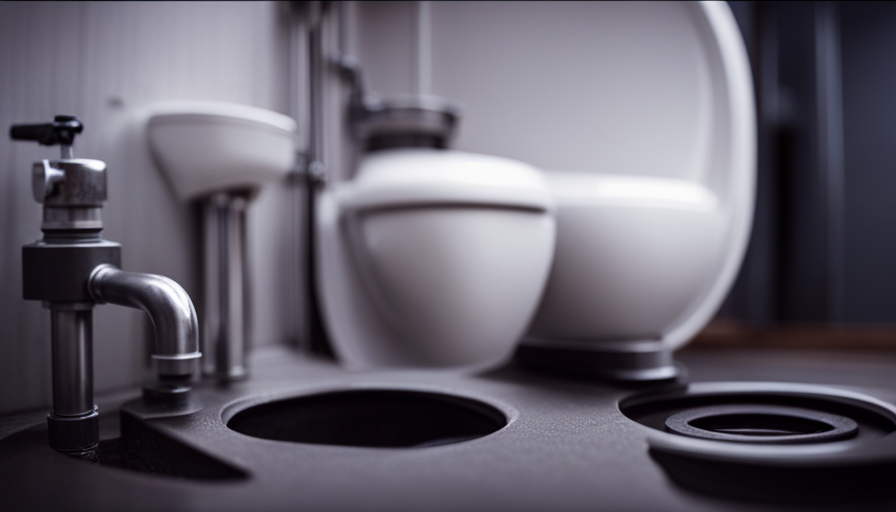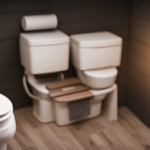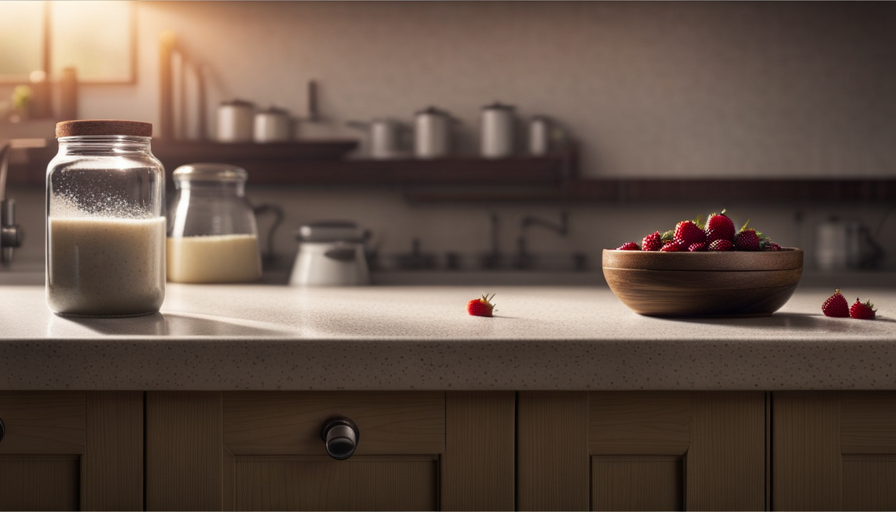Regarding the subject of toilets in small homes, some may hesitate to engage in conversations about the more unglamorous details. Yet, in the realm of tiny living, the performance and effectiveness of a toilet are absolutely critical.
So, let’s dive into the intriguing world of tiny house toilets. In this article, I will explore various types of toilets that work seamlessly in small spaces, such as composting toilets, incinerating toilets, chemical toilets, portable toilets, and waterless toilets.
I will also delve into the plumbing and waste management systems that make these toilets work effectively. Furthermore, I will discuss space-saving toilet designs and provide valuable tips on choosing the right toilet for your tiny house.
Lastly, I will share important maintenance and care tips to ensure your toilet remains in optimal working condition. Get ready to learn all about the fascinating world of toilets in tiny houses!
Key Takeaways
- Tiny houses have various toilet options such as composting toilets, incinerating toilets, chemical toilets, and portable toilets.
- Composting toilets and waterless toilets are eco-friendly and require regular maintenance for optimal functioning.
- Factors to consider when choosing a toilet for a tiny house include budget, long-term usage, personal preferences, available space, and environmental impact.
- Regular cleaning and maintenance are essential for efficient functioning, hygiene, odor control, and early detection of leaks and water damage.
Composting Toilets
Composting toilets are a fantastic option for tiny house owners who want a sustainable and eco-friendly way to handle their waste. They not only provide a way to effectively manage human waste, but they also offer numerous benefits.
One of the main advantages of composting toilets is their ability to turn waste into nutrient-rich compost. This compost can then be used to fertilize gardens or plants, making it a valuable resource. Additionally, composting toilets don’t require any water for flushing, which is especially beneficial for those living in areas with limited water supply.
Installing a composting toilet in a tiny house is relatively straightforward. The toilet typically consists of a separate chamber for solid waste and a separate container for liquid waste. The solid waste chamber is filled with organic material, such as sawdust or peat moss, which helps facilitate the composting process. The liquid waste is diverted to a separate container or can be used for composting as well.
Transitioning to the subsequent section about incinerating toilets, it’s important to note that composting toilets are a great option for those who prioritize sustainability and want to minimize their environmental impact. However, some tiny house owners may prefer the convenience and efficiency of incinerating toilets.
Incinerating Toilets
Using an incinerating toilet in your small space creates a visually efficient and odor-free waste management system. Incinerating toilets are a popular choice for tiny houses due to their compact size and minimal maintenance requirements.
One of the key benefits of incinerating toilets is that they eliminate the need for water, making them a sustainable option for off-grid living. These toilets use electricity to heat waste to high temperatures, reducing it to a sterile ash that can be easily disposed of. This process also eliminates any odor, ensuring a pleasant environment in your tiny house.
Maintenance for incinerating toilets is relatively simple. They typically have a removable ashtray or container where the waste is collected. Once the ashtray is full, it can be emptied and the ash disposed of properly. Some models may require occasional cleaning of the heating element or other components, but overall, the maintenance is minimal compared to traditional flush toilets.
Transitioning to the next section about ‘chemical toilets’, these alternatives provide another option for waste management in tiny houses.
Chemical Toilets
When it comes to chemical toilets, there are a few key points to consider. First, let’s talk about functionality and usage.
Chemical toilets work by using chemicals to break down waste and neutralize odors. They are commonly used in situations where traditional plumbing is not available, such as in tiny houses or camping trailers.
Now let’s discuss the pros and cons.
One advantage of chemical toilets is their portability and ease of installation. They can be easily moved and set up in different locations. However, one drawback is the ongoing cost of purchasing chemicals for maintenance.
Lastly, let’s touch on proper disposal and maintenance.
It is important to follow the manufacturer’s instructions for disposing of waste and maintaining the toilet. This typically involves emptying the waste tank at designated disposal stations and regularly cleaning the toilet to prevent buildup and ensure proper functioning.
Functionality and usage
To maximize space in a tiny house, you’ll need to understand how the toilet functions and the effectiveness of its compact design. A composting toilet is a popular choice for tiny houses due to its numerous benefits. Firstly, it eliminates the need for water, making it an eco-friendly option. Secondly, it converts waste into compost, which can be used as fertilizer for plants. This dual functionality reduces waste and helps create a sustainable living environment.
Waterless toilet options, such as incinerating toilets, are also available for tiny houses. These toilets use high temperatures to burn waste, leaving behind only a small amount of ash. This innovative technology eliminates the need for plumbing and provides a convenient solution for tiny house dwellers.
Transitioning to the next section about the pros and cons, it is important to weigh the benefits of these toilets against their potential drawbacks.
Pros and cons
One thing to consider is the advantages and disadvantages of opting for a composting or incinerating toilet in your small living space.
Composting toilets are a popular choice for tiny houses due to their eco-friendly nature. They use natural processes to break down waste into compost, which can be safely disposed of. These toilets are also portable, allowing for flexibility in placement within the tiny house. However, they do require regular maintenance, such as adding bulking agents and ensuring proper ventilation.
On the other hand, incinerating toilets use heat to reduce waste to ash, eliminating the need for composting. They are compact and easy to install, but they require a power source and can be more expensive.
Transitioning into the next section about proper disposal and maintenance, it’s important to understand the specific guidelines for each type of toilet to ensure safe and effective operation.
Proper disposal and maintenance
Take care of your composting or incinerating toilet by following proper disposal and maintenance guidelines, ensuring a hygienic and hassle-free experience in your small living space. Composting toilets are a popular choice for tiny houses due to their eco-friendly nature and budget-friendly alternatives. These toilets work by breaking down waste into compost, which can be used as fertilizer for plants. To properly dispose of waste in a composting toilet, separate solid and liquid waste, and add a carbon-rich material like sawdust or coconut coir. Regularly empty the solids compartment and maintain the ventilation system to prevent odors. Incinerating toilets, on the other hand, use heat to burn waste into ash, which can be easily disposed of. These toilets require electricity and regular cleaning to ensure proper functioning. Transitioning to portable toilets, which offer convenience and mobility, is another option for tiny house owners.
Portable Toilets
With a wave of my hand, I can magically make my waste disappear when using portable toilets in my tiny house. Portable toilet options are a great alternative for those who want a convenient and easy-to-use solution for their bathroom needs.
There are different types of portable toilets available, including flushable and composting options. Flushable portable toilets work similarly to regular toilets, using water to flush waste away into a holding tank. These tanks can be easily emptied and cleaned when full.
Composting portable toilets, on the other hand, use a different method to dispose of waste. They separate liquid and solid waste, with the solid waste being composted and the liquid waste being evaporated or drained. This makes them a more eco-friendly option.
Transitioning to the next section about waterless toilets, it’s important to note that while portable toilets provide a convenient solution, waterless toilets offer an even more sustainable and efficient option for tiny house living.
Waterless Toilets
Waterless toilets are a unique alternative to traditional flush toilets that don’t require any water for operation. They work by using a combination of natural processes such as decomposition and evaporation to break down waste.
One of the main benefits of waterless toilets is their environmental sustainability, as they conserve water and reduce the strain on sewage systems. However, there are some considerations to keep in mind, such as the need for regular maintenance to ensure proper functioning and odor control.
How they work
Toilets in tiny houses operate using a compact system that efficiently manages waste disposal. Composting toilets, also known as waterless toilets, are a popular choice for tiny houses due to their eco-friendly and space-saving features. Here’s a breakdown of how they work:
-
Separation: Composting toilets separate liquid and solid waste, preventing odor and facilitating the composting process.
-
Ventilation: A ventilation system ensures proper airflow, aiding in decomposition and reducing any potential smells.
-
Decomposition: Microorganisms present in the composting toilet break down the solid waste into organic matter, resembling compost.
-
Maintenance: Regular maintenance is essential, including adding bulking agents like sawdust or coconut coir and periodically emptying the compost.
Composting toilets offer several benefits, such as reducing water usage and producing nutrient-rich compost. However, there are some considerations to keep in mind, such as the need for adequate ventilation and occasional maintenance.
Benefits and considerations
Imagine the freedom of significantly reducing your water consumption and creating nutrient-rich compost with a composting toilet in your tiny house. Composting toilets offer a range of benefits that make them an excellent choice for small living spaces.
Firstly, they are waterless, meaning you can save thousands of gallons of water each year. This not only helps the environment but also reduces your water bills.
Additionally, composting toilets turn waste into compost, which can be used as fertilizer for your garden. This eliminates the need for chemical-based fertilizers, making your gardening more sustainable.
However, there are considerations to keep in mind. You’ll need to properly manage the composting process to ensure odor control and prevent any potential health risks.
Transitioning into the next section, let’s explore maintenance and odor control techniques to keep your composting toilet functioning efficiently.
Maintenance and odor control
Now that we’ve discussed the benefits and considerations of having a toilet in a tiny house, let’s delve into the important aspects of maintenance and odor control. Keeping your toilet clean and odor-free is crucial for maintaining a comfortable living environment.
Here are some maintenance tips to help you achieve that:
-
Regular cleaning: Clean your toilet bowl and seat with a mild cleaner at least once a week.
-
Check for leaks: Inspect the toilet regularly for any leaks or loose connections.
-
Use odor control products: Consider using odor control tablets or sprays to keep your tiny house smelling fresh.
Proper maintenance and odor control are essential for a pleasant bathroom experience in a tiny house.
Now, let’s move on to exploring some DIY toilet options for those who prefer a more hands-on approach.
DIY Toilet Options
In this section, I’ll discuss creative and budget-friendly alternatives for DIY toilets in tiny houses. I’ll provide building and installation tips to help you create your own toilet system. Additionally, I’ll address safety and regulations to ensure that your DIY toilet meets all necessary standards.
Creative and budget-friendly alternatives
Looking for a creative and budget-friendly alternative? Why not try out a composting toilet in your tiny house – it’s not only eco-friendly but also saves you money!
Composting toilets are a great option for tiny houses because they don’t require water or plumbing connections. These toilets use natural processes to break down waste into compost, which can be used as fertilizer for plants.
There are various portable options available, such as self-contained composting toilets that have a separate container for waste and a built-in composting system. These toilets typically use a combination of organic material, like sawdust or coconut coir, to aid in the composting process.
When it comes to building and installation tips for composting toilets, it’s important to consider ventilation, proper sealing, and regular maintenance. By following these guidelines, you can ensure a functional and efficient composting toilet system for your tiny house.
Building and installation tips
If you’re ready to tackle the challenge, constructing and setting up a composting toilet can be a breath of fresh air in your compact sanctuary, like adding the final brushstroke to a masterpiece.
When it comes to tiny house toilets, there are two main types to consider: composting and chemical toilets. Composting toilets are a popular choice for their eco-friendliness and low maintenance. They use natural processes to break down waste into compost that can be safely disposed of. On the other hand, chemical toilets use chemicals to mask odors and break down waste.
When it comes to compact toilet designs, there are various options available, including self-contained units and separating systems. These designs are specifically created to maximize space efficiency in small living areas.
As you dive into the world of tiny house toilets, it’s important to also consider safety and regulations, ensuring that your setup meets all necessary requirements.
Safety and regulations
To ensure the safety and compliance of your compact sanctuary, it’s crucial that you familiarize yourself with the necessary regulations and guidelines for your chosen toilet system. Here are some key safety regulations to keep in mind when it comes to waste disposal in your tiny house:
-
Proper waste containment: Make sure your toilet system has a secure and tightly sealed waste containment unit to prevent any leaks or odors.
-
Ventilation: Install a ventilation system to ensure proper airflow and eliminate any potential build-up of harmful gases.
-
Waste disposal guidelines: Follow local regulations for disposing of waste from your toilet system, whether it’s through composting, septic systems, or other approved methods.
-
Regular maintenance: Regularly inspect and maintain your toilet system to ensure it’s functioning properly and safely.
-
Safety precautions: Always handle waste materials with caution, wearing protective gear if necessary.
With these safety regulations in mind, let’s now move on to the next section about plumbing and waste management systems.
Plumbing and Waste Management Systems
One of the most crucial aspects of tiny house living is understanding how the plumbing and waste management systems work. In a tiny house, space is limited, making traditional plumbing systems impractical. As a result, many tiny house owners opt for alternative solutions such as composting toilets or waterless toilets. These innovative systems provide a sustainable and environmentally friendly way to manage waste in a tiny space.
Composting toilets are designed to turn human waste into compost through a natural decomposition process. They use little to no water, which is a significant advantage in a tiny house where water supply may be limited. These toilets separate liquid and solid waste, with the liquid being evaporated and the solid waste breaking down into compost over time.
Waterless toilets, on the other hand, use chemicals or natural materials to neutralize odors and break down waste. These systems typically require a cartridge or bag that needs to be replaced periodically.
To better understand the differences between composting toilets and waterless toilets, refer to the table below:
| Composting Toilets | Waterless Toilets | |
|---|---|---|
| Water Usage | Little to none | None |
| Waste Management | Composting | Chemical or natural breakdown |
| Odor Control | Natural decomposition process | Chemical or natural neutralization |
Understanding the various options for managing waste in a tiny house is essential for creating a functional and comfortable living space. In the next section, we will explore space-saving toilet designs that are commonly used in tiny houses.
Space-saving Toilet Designs
Get ready to discover the genius space-saving toilet designs that’ll revolutionize your tiny living experience! When it comes to tiny houses, every inch of space matters, including the bathroom.
Luckily, there are several innovative toilet options available that maximize space while still providing functionality. Here’s a comparison of some space-saving solutions:
-
Compact toilets: These toilets are designed to be smaller in size, with reduced dimensions and a more streamlined shape. They’re perfect for tiny bathrooms as they take up less floor space.
-
Corner toilets: These toilets are specifically designed to fit into the corners of a bathroom. By utilizing the corner space, they help save precious square footage and create a more open feel.
-
Wall-mounted toilets: These toilets are attached directly to the wall, eliminating the need for a bulky base. By taking advantage of vertical space, they free up valuable floor area.
-
All-in-one toilets: These toilets combine multiple functions into a single unit, such as a toilet, sink, and storage. They’re a great space-saving solution, especially for bathrooms with limited square footage.
Comparing these options will help you choose the right toilet for your tiny house. By incorporating these space-saving designs, you can maximize the functionality of your bathroom without sacrificing comfort or style.
Now, let’s explore how to choose the perfect toilet for your unique needs.
Choosing the Right Toilet for Your Tiny House
When choosing the right toilet for a tiny house, there are several factors to consider.
Firstly, budget and long-term usage play a crucial role in determining the type of toilet that would be most suitable.
Secondly, personal preferences and lifestyle should also be taken into account, as different individuals may have different needs and requirements when it comes to their toilet.
Lastly, it is important to assess the available space in the tiny house and choose a toilet that maximizes efficiency without compromising on comfort.
Factors to consider
Before diving into the details of how a toilet works in a tiny house, it’s important to take into account various factors. When choosing the right toilet for your tiny house, there are a few key considerations to keep in mind:
- Type of toilet: Composting toilets and waterless toilets are popular choices for tiny houses due to their efficient use of space and minimal water requirements.
- Installation requirements: Consider the space available and whether you have access to plumbing and electricity for traditional flush toilets.
- Maintenance needs: Composting toilets require regular emptying and proper maintenance to ensure odor-free operation.
- Environmental impact: Look for toilets that are eco-friendly and have low water consumption.
Considering these factors will help you make an informed decision about the best toilet for your tiny house.
Moving forward, let’s discuss budget and long-term usage in relation to toilet selection.
Budget and long-term usage
Considering your budget and how often you plan to use it, it’s important to carefully consider the long-term usage of your chosen toilet for your compact dwelling. When it comes to budget constraints, it’s crucial to find a toilet that not only fits within your financial limitations but also offers durability and low maintenance. Look for options that have a proven track record of longevity and can withstand the demands of everyday use.
Additionally, considering the environmental impact is important. Opt for toilets that are designed to be water-efficient, as they can significantly reduce your water consumption and lower your utility bills in the long run. By choosing a toilet that meets both your budget and environmental needs, you can ensure a sustainable and cost-effective solution for your tiny house lifestyle.
Transitioning into the subsequent section about personal preferences and lifestyle, let’s now explore the different options available.
Personal preferences and lifestyle
Get ready to dive into the exciting world of personal preferences and lifestyle as we explore the plethora of options available for your dream compact dwelling! When it comes to choosing a toilet for your tiny house, personal preferences play a significant role.
Consider the following factors to ensure the toilet fits seamlessly into your lifestyle:
-
Size: Determine the dimensions and shape of the toilet that best suits your space and comfort requirements.
-
Water usage: Decide between water-saving options like composting toilets or low-flush toilets, based on your environmental concerns.
-
Odor control: Explore toilets with built-in ventilation or odor-neutralizing features to maintain a fresh and pleasant atmosphere.
-
Maintenance: Consider the ease of cleaning and emptying the toilet, especially if you plan to live in your tiny house long-term.
Now that you’ve considered your personal preferences and lifestyle, let’s move on to maintenance and care tips to ensure your toilet functions optimally.
Maintenance and Care Tips
When it comes to maintaining and caring for a toilet in a tiny house, there are some key points to keep in mind.
First and foremost, regular cleaning and sanitization are essential to ensure proper hygiene and prevent any unpleasant odors.
Additionally, establishing a regular maintenance schedule is crucial to keep the toilet functioning efficiently and avoid any potential issues.
Lastly, being familiar with common troubleshooting techniques will help address and resolve any common toilet problems that may arise.
Cleaning and sanitization
To keep your tiny house toilet clean and sanitary, regular maintenance is essential. Deep cleaning is an important step in ensuring the cleanliness of your toilet.
Start by removing any detachable parts, such as the seat and lid, and clean them separately using a mild detergent. Next, use a toilet brush and eco-friendly cleaning solution to scrub the bowl thoroughly, paying attention to hard-to-reach areas. Rinse with water and dry with a clean cloth.
Additionally, consider using eco-friendly options, such as vinegar or baking soda, to clean and deodorize your toilet. These natural alternatives are effective and environmentally friendly.
By incorporating these cleaning methods into your routine, you can maintain a hygienic toilet in your tiny house.
Moving on to the next section, establishing a regular maintenance schedule will ensure the longevity of your toilet system.
Regular maintenance schedule
Establishing a regular maintenance schedule for your toilet ensures its longevity and keeps it functioning smoothly, just like a well-oiled machine. By following a routine maintenance schedule, you can prevent unpleasant odors and maintain a clean and hygienic environment in your tiny house. Here is a table outlining a suggested regular maintenance schedule for your toilet:
| Maintenance Task | Frequency |
|---|---|
| Clean the toilet bowl | Weekly |
| Check for leaks or water damage | Monthly |
| Inspect and clean the flush mechanism | Every 3 months |
| Deep clean the toilet and drain pipes | Every 6 months |
Regularly cleaning the toilet bowl helps to control odors and prevent buildup. Additionally, checking for leaks and water damage ensures early detection and prevents further damage. Inspecting and cleaning the flush mechanism helps maintain proper functionality, and deep cleaning the toilet and drain pipes eliminates any accumulated grime or clogs. By following this regular maintenance schedule, you can minimize potential issues and ensure your toilet operates efficiently. In the next section, we will discuss troubleshooting common issues that may arise.
Troubleshooting common issues
Having a well-maintained toilet is essential, but what do you do when common issues arise? Troubleshooting leaks and resolving clogging issues are two common problems that can occur with toilets in tiny houses.
When it comes to leaks, the first step is to identify the source. Check the water supply line, tank bolts, and wax ring for any signs of leakage. Tighten loose connections or replace faulty parts as needed. If the toilet is still leaking, it may be necessary to call a professional plumber.
Clogging issues can often be resolved by using a plunger or a toilet auger to clear the blockage. Avoid using harsh chemicals, as they can damage the plumbing system.
Regular maintenance, such as regular cleaning and proper waste disposal, can help prevent these issues from occurring in the first place.
Frequently Asked Questions
What are the benefits of using a composting toilet in a tiny house?
Composting toilets offer a plethora of benefits in the realm of tiny house living. Firstly, they provide an environmentally-friendly solution by converting waste into nutrient-rich compost. This not only reduces water usage but also eliminates the need for costly sewage systems.
Secondly, composting toilets are highly cost-effective, as they require minimal maintenance and no additional expenses for sewage hookups or regular pumping. Incorporating a composting toilet in a tiny house ensures sustainable living with financial savings.
Are incinerating toilets safe to use in a tiny house?
Yes, incinerating toilets are safe to use in a tiny house. They’re designed to efficiently burn waste at high temperatures, eliminating any potential health risks. However, there are alternative toilet options available for tiny houses, such as composting toilets. These toilets use natural processes to break down waste into compost, which can then be safely disposed of. Ultimately, the choice between incinerating and composting toilets depends on personal preference and the specific needs of the tiny house owner.
How do chemical toilets work and are they environmentally friendly?
Chemical toilets work by breaking down waste using chemicals and enzymes. One example of a chemical toilet is the Nature’s Head composting toilet. It uses a mixture of coconut coir and peat moss to aid in the decomposition process. When waste is added, the toilet separates liquid and solid waste. The solid waste is mixed with the coconut coir and peat moss, which helps to control odor and speed up decomposition.
It is an environmentally friendly option as it reduces water usage and produces compost that can be used as fertilizer. This type of sustainable sanitation is becoming increasingly popular in tiny houses.
What are the advantages of using a portable toilet in a tiny house?
Using a portable toilet in a tiny house has several advantages. Firstly, it’s cost-effective as it eliminates the need for expensive plumbing installations.
Additionally, portable toilets are easy to maintain as they require minimal cleaning and can be emptied easily. They’re designed with user convenience in mind and often come with features like built-in waste containers and odor control systems.
Overall, using a portable toilet in a tiny house provides a practical and hassle-free solution for bathroom needs.
How do waterless toilets function and do they require any special maintenance?
Waterless toilets, like the name suggests, function without the need for water. Instead, they use innovative systems to decompose waste into compost or evaporate it. These toilets are hygienic and odorless, utilizing natural processes to break down waste.
As for maintenance, waterless toilets require minimal care. Regular emptying and cleaning are necessary, but they don’t demand any special procedures.
Overall, waterless toilets offer a sustainable and convenient solution for tiny house living.
Conclusion
In conclusion, the world of tiny house toilets is a fascinating and innovative one.
From composting toilets that turn waste into valuable fertilizer, to incinerating toilets that eliminate waste completely, there are a variety of options to choose from.
Chemical toilets offer a convenient solution for those on the go, while portable toilets provide flexibility and ease of use.
Waterless toilets save water and space, while plumbing and waste management systems ensure efficient disposal.
With space-saving designs and careful consideration, finding the right toilet for your tiny house is an adventure in itself.
So, embark on this journey and let your imagination run wild with the possibilities!
Hi, I’m Emma. I’m the Editor in Chief of Tiny House 43, a blog all about tiny houses. While tree houses are often associated with childhood, they can be the perfect adult retreat. They offer a cozy space to relax and unwind, surrounded by nature. And since they’re typically built on stilts or raised platforms, they offer stunning views that traditional homes simply can’t match. If you’re looking for a unique and romantic getaway, a tree house tiny house might just be the perfect option.
















